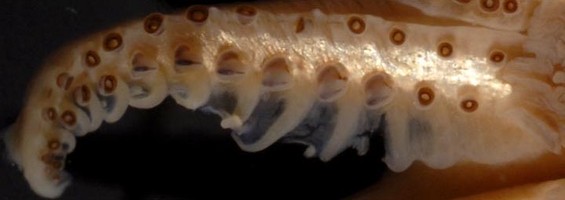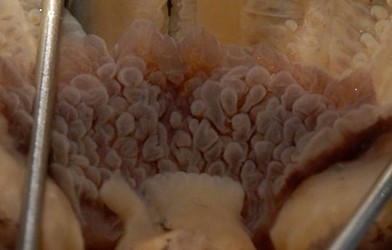Pterygioteuthis gemmata group
Annie Lindgren, Richard E. Young, and Katharina M. Mangold (1922-2003)


This tree diagram shows the relationships between several groups of organisms.
The root of the current tree connects the organisms featured in this tree to their containing group and the rest of the Tree of Life. The basal branching point in the tree represents the ancestor of the other groups in the tree. This ancestor diversified over time into several descendent subgroups, which are represented as internal nodes and terminal taxa to the right.

You can click on the root to travel down the Tree of Life all the way to the root of all Life, and you can click on the names of descendent subgroups to travel up the Tree of Life all the way to individual species.
For more information on ToL tree formatting, please see Interpreting the Tree or Classification. To learn more about phylogenetic trees, please visit our Phylogenetic Biology pages.
close boxIntroduction
Brief Diagnosis:
A Pterygioteuthis with...
- hooks in a single, ventral series on arms I-III.
- tentacular club suckers on manus with dorsal series enlarged.
- eyes each with 10 large and 4 minute photophores.
Characteristics
- Arms - hooks in 1 series (ventral) on arms I-III.
 Click on an image to view larger version & data in a new window
Click on an image to view larger version & data in a new window
Figure. Oral view of an arm III from a female P. gemmata. ©
- Arms I - distal suckers are normal in appearance.
- Arms IV - males and females with suckers in 2 series; location and size vary with sex and species.
- Hectocotylus plate - contains many small teeth
- Arms I - distal suckers are normal in appearance.
- Tentacular clubs - suckers (4 series) on manus with dorsal series enlarged.
 Click on an image to view larger version & data in a new window
Click on an image to view larger version & data in a new window
Figure. Oral view of a tentacle club from P. microlampas. ©
- Buccal membrane - with irregular papillae on inner surface.
- Eye photophores - 10 large and 4 minute (see arrows below).
Discussion of Phylogenetic Relationships
Pterygioteuthis gemmata and P. microlampas are morphologically similar: both possess 4 small photophores on the eye, 4 tentacular photophores, and a hectocotulys plate with many small teeth. Historically there has been substantial debate over whether P. microlampas is a distinct species or a subspecies of P. gemmata, but authors have been reluctant to synonymize the two given that some morphological and biogeographical differences exist (e.g. Riddell, 1985; Young, 1972). Lindgren (2010) found P. microlampas most easy to distinguish from P. gemmata by its relatively smaller size (mature specimens P. gemmata have a gladius length greater than 17mm) and by the fewer number of hooks on arms III (P. microlampas generally has less than 4 hooks).Distribution
Members of the Pterygioteuthis gemmata group appear to occupy fairly distinct geographic regions. P. microlampas has been found both in waters off the Hawaiian Islands and New Zealand (Riddell, 1985), but not in the open ocean. However, this sampling bias may be due to the lack of sampling in the open ocean between Hawaii and New Zealand. P. gemmata is found in temperate waters throughout the Atlantic. In the Pacific, P. gemmata is found in large numbers off the coast of Southern California (Okutani, 1974) and Baja but does not occur in the eastern tropical Pacific (Lindgren, 2010).
References
Lindgren, A.R. 2010. Systematics and distribution of the squid genus Pterygioteuthis (Cephalopoda: Oegopsida) in the eastern tropical Pacific Ocean. Journal of Molluscan Studies, 76(4): 398-398.
Okutani, T. 1974. Epipelagic decapod cephalopods collected by midwater tows during the EASTROPAC Expedition, 1967-1968 (systematic part). Bull. Tokai Reg. Fish. Res. Lab. 80: 29-118.
Riddell, D.J. 1985. Enoploteuthidae of New Zealand. Fish. Res. Bull. New Zealand. 27:1-52.
Title Illustrations

| Scientific Name | Pterygioteuthis microlampas |
|---|---|
| Location | Hawaiian waters |
| View | ventrolateral |
| Image Use |
 This media file is licensed under the Creative Commons Attribution-NonCommercial License - Version 3.0. This media file is licensed under the Creative Commons Attribution-NonCommercial License - Version 3.0.
|
| Copyright |
© 1996

|
About This Page

Ohio State University, Columbus, Ohio, USA

University of Hawaii, Honolulu, HI, USA
Katharina M. Mangold (1922-2003)

Laboratoire Arago, Banyuls-Sur-Mer, France
Correspondence regarding this page should be directed to Annie Lindgren at and Richard E. Young at
Page copyright © 2011 and
 Page: Tree of Life
Pterygioteuthis gemmata group.
Authored by
Annie Lindgren, Richard E. Young, and Katharina M. Mangold (1922-2003).
The TEXT of this page is licensed under the
Creative Commons Attribution-NonCommercial License - Version 3.0. Note that images and other media
featured on this page are each governed by their own license, and they may or may not be available
for reuse. Click on an image or a media link to access the media data window, which provides the
relevant licensing information. For the general terms and conditions of ToL material reuse and
redistribution, please see the Tree of Life Copyright
Policies.
Page: Tree of Life
Pterygioteuthis gemmata group.
Authored by
Annie Lindgren, Richard E. Young, and Katharina M. Mangold (1922-2003).
The TEXT of this page is licensed under the
Creative Commons Attribution-NonCommercial License - Version 3.0. Note that images and other media
featured on this page are each governed by their own license, and they may or may not be available
for reuse. Click on an image or a media link to access the media data window, which provides the
relevant licensing information. For the general terms and conditions of ToL material reuse and
redistribution, please see the Tree of Life Copyright
Policies.
- First online 11 January 2011
- Content changed 11 January 2011
Citing this page:
Lindgren, Annie, Richard E. Young, and Katharina M. Mangold (1922-2003). 2011. Pterygioteuthis gemmata group. Version 11 January 2011 (under construction). http://tolweb.org/Pterygioteuthis_gemmata_group/110604/2011.01.11 in The Tree of Life Web Project, http://tolweb.org/











 Go to quick links
Go to quick search
Go to navigation for this section of the ToL site
Go to detailed links for the ToL site
Go to quick links
Go to quick search
Go to navigation for this section of the ToL site
Go to detailed links for the ToL site